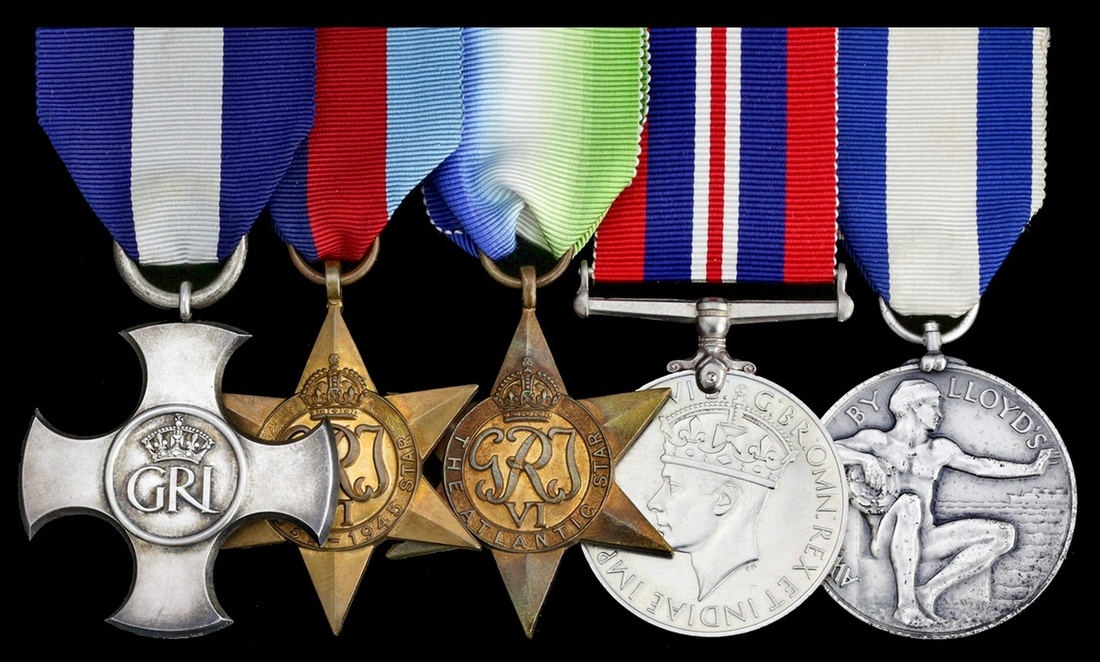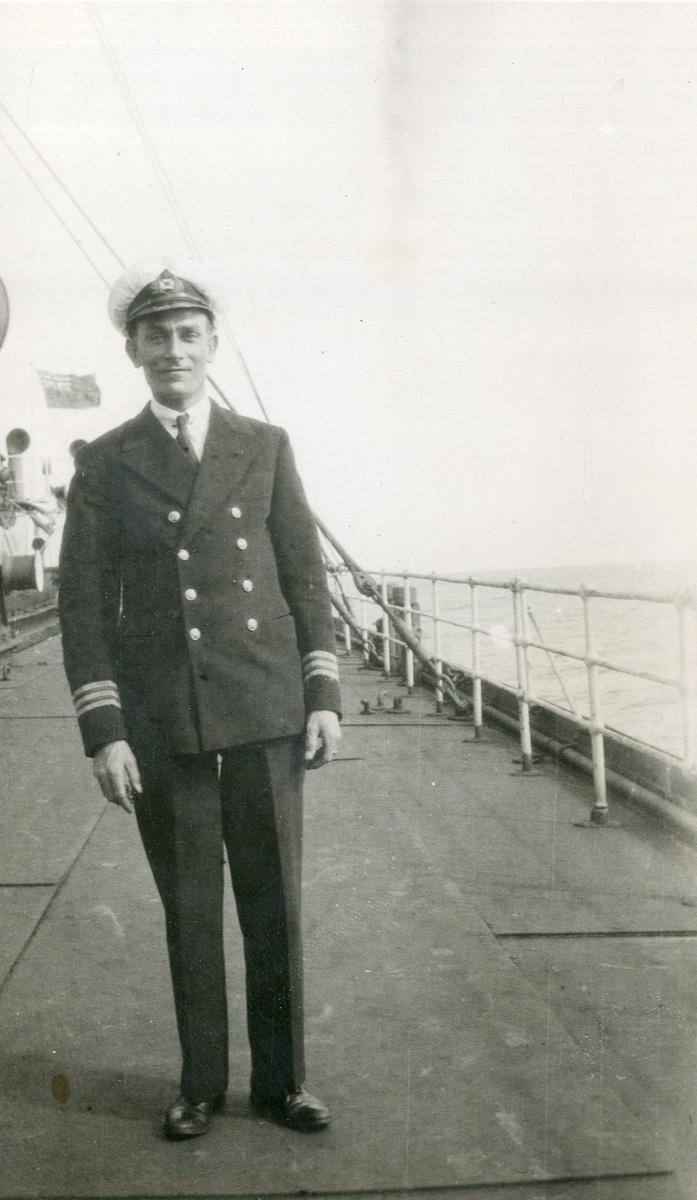Auction: 18001 - Orders, Decorations and Medals
Lot: 583
'Pinpoint AT. 4876, two freighters disappeared southwards. Have sunk 'Alcoa Ranger', ex New York, 5116 tones - aircraft. Big merchant vessel broke away to the north-west just beforehand. Am following hard.'
So states the operational log book kept by Kapitain Reche in the U-255, who was taking part in the slaughter that followed the infamous order for Arctic convoy PQ-17 to scatter: as it transpired the 'big merchant vessel' - the Empire Tide - escaped her pursuer as she disappeared into the 'fog banks and sea-smoke that swirled and fumed about the floes and growlers'
The exceptional Second World War 'PQ-17' D.S.C. and Lloyd's War Medal for Bravery at Sea group of five awarded to Chief Engineer Officer A. H. Hughes, Merchant Navy
But for his gallant exertions deep in the engine-room of the Empire Tide - no place to be after PQ-17 was ordered to scatter - it is likely his ship would have shared the same fate as 23 other merchantmen lost to merciless Luftwaffe and Wolfpack attack
He was subsequently killed in the S.S. Nebraska when she was torpedoed off Ascension Island in April 1944
Distinguished Service Cross, G.VI.R., hallmarks for London 1942, the reverse officially dated '1942' and further inscribed, 'Chief Engr. A. H. Hughes, July 1942', in its Garrard & Co. case of issue; 1939-45 Star; Atlantic Star; War Medal 1939-45, in their original card forwarding box addressed to 'Mrs. E. V. Hughes, 123 Belvidere Rd., Wallasey, Cheshire', with Minister of Transport condolence slip in the name of 'Albert Henry Hughes, D.S.C.'; Lloyd's War Medal for Bravery at Sea (Chief Engineer Officer A. H. Hughes, M.V. "Empire Tide", 4th July 1942), in its fitted case of issue, good very fine or better (5)
D.S.C. London Gazette 22 December 1942:
'For fortitude, seamanship and endurance in taking merchantmen to North Russia through heavy seas and in the face of relentless attacks by enemy aircraft.'
Lloyd's War Medal for Bravery at Sea Lloyd's List & Shipping Gazette 3 February 1944. The joint citation states:
'The vessel was attacked by enemy aircraft almost continuously for five days and nights while proceeding to a North Russian port. Two of the enemy were destroyed. After the attack ceased, enemy submarines were sighted and a nearby vessel was torpedoed. By taking evasive action and increasing speed to the utmost, Captain Hervey was able to get away from the enemy. Throughout the whole period of the attacks Chief Engineer Hughes and Second Engineer Griffiths remained in the engine-room, and by their efforts ensured the utmost possible speed under conditions of great stress. Although almost over come by lack of sleep they carried on with the pumping out of water ballast and the handling of the main engines until the vessel was refloated. It was mainly due to the inspiring leadership and courage of the Master and the magnificent conduct of the two engineer officers that the ship was brought to port. Chief Steward Carswell behaved with outstanding courage in the face of great danger when a gunner was wounded during the action with enemy aircraft. He made his way to the gun position and carried the gunner down to the ship's hospital. There he inserted sixteen stitches in the man's leg while the attack on the vessel proceeded. But for the prompt action and skill of Mr. Carswell, the wounded man might have lost his life.'
'Convoy is to Scatter'
The fate of PQ-17 has been graphically described by such historians as David Irving (The Destruction of Convoy PQ. 17), and by Richard Woodman (Arctic Convoys 1941-45), but in terms of more immediate statistics it is worth recording that the convoy originally assembled at Reykjavik on 27 June 1942, a formidable gathering that in addition to the naval escort comprised 22 American, eight British, two Russian, two Panamanian and one Dutch merchantmen. In their holds they carried sufficient supplies to re-arm a good portion of the Stalin's forces - 297 aircraft, 594 tanks, 4246 military vehicles and over 150,000 tons of other vital military stores and cargo: but most of this equipment never reached Russia, for just a few days later - following Sir Dudley Pound's fateful order for the convoy to scatter - no less that 23 of the merchantmen were lost to enemy action.
One of the lucky few to make it home to the U.K., after attracting the attention of the Luftwaffe and U-boats over several days, was the C.A.M. ship Empire Tide, but not before many close-calls and adventures. Nor were those close-calls the sole result of enemy action. On 4 July 1942, when Heinkel 111 torpedo-bombers of KG. 26 launched an attack, the convoy's resultant defensive barrage hit the Empire Tide, damaging her rigging and derrick spars, and blowing away her gun telephone communications. This was probably the one occasion that her 'Hurricat' may have been launched with good effect, but with 'friendly fire' pouring over Empire Tide's bows, it was deemed too risky for F./O. 'Dickie' Turley-George to make the attempt; a full and entertaining account of his experiences during PQ-17 may be found in Ralph Barker's The Hurricats.
The majority of the 23 merchantmen to be lost in the convoy were victims of U-boat attack following the order to scatter. That Empire Tide escaped a similar fate is remarkable indeed and, as per the Lloyd's citation for their Medals for Bravery at Sea, largely attributable to the magnificent work undertaken by Hughes and his fellow engineer officer deep in the Empire Tide's engine room. That fine work enabled Captain F. W. Harvey - who sighted no less than three surfaced U-boats - to make haste for Moller Island at 'all possible speed'.
Just how close Empire Tide came to sharing the fate of so many other merchantmen may be gleaned from the operational log book of Kapitain Reche in the U-255:
'Pinpoint AT. 4876, two freighters disappeared southwards. Have sunk Alcoa Ranger, ex New York, 5116 tones - aircraft. Big merchant vessel broke away to the north-west just beforehand. Am following hard.'
That 'big merchant vessel' was none other than Empire Tide, but Reche never caught her as she disappeared into the 'fog banks and sea-smoke that swirled and fumed about the floes and growlers'. Empire Tide reached the anchorage at Moller Bay on Novaya Zemlya's south-western coast, where there was a wireless station and small settlement, thereby allowing Captain Harvey to send a message to Archangel requesting urgent medical assistance for his wounded gunner; in due course a Russian Catalina arrived with a woman doctor.
Organising the evacuation of his only serious casualty was just the beginning of Captain Harvey's troubles, for over the next few days significant numbers of survivors pitched up at his barren refuge in assorted lifeboats and rafts, many of them in a seriously bad way.
Before too long Empire Tide's new residents had numerically swollen out of all proportion, a position that put Harvey and his crew under great strain - the casualties were quartered in the officer's smoke room. At length, and with no pressure from Harvey and his crew, many of the new arrivals elected to go ashore, a decision that was duly recorded by Harvey in a signed declaration that rejected all liability for them - such was the tension that had built up over the intervening period. As it transpired, the 'campers' had to return to the Empire Tide red-faced, when salvation arrived in the form of a strong naval escort. On 21 July the Empire Tide set course for Archangel, which port she reached without further incident on the 24th. Then in the second week of September, she undertook the return voyage to the U.K.
Empire Tide's Master, Captain F. W. Harvey, was awarded the D.S.O., while Hughes and his fellow engineer officer received the D.S.C.; three members of her crew were awarded D.S.M.s and two others the B.E.M. Four of these recipients were also received the Lloyd's War Medal for Bravery at Sea: Just 104 of the latter being awarded in the last war.
Hughes received his D.S.C. at an investiture held on 9 March 1943.
For extracts from the reminiscences of Horace Carswell, D.S.M., M.M., B.E.M., Empire Tide's gallant steward, see:
http://www.naval-history.net/WW2Memoir-PQ17-Carswell.htm
Hughes subsequently returned to sea in the S.S. Nebraska and was similarly employed when she was torpedoed by the U-843 off Ascension Island on 8 April 1944. He was one of two men killed in the explosion caused by the opening torpedo strike, for the U-Boat commander made two further attacks before the Nebraska was sunk.
The husband of Evelyn Victoria Hughes, Albert was 46 years old. He has no known grave and is commemorated on the Tower Hill Memorial.
Sold with a quantity of original documentation, comprising:
(i)
Buckingham Palace investiture admittance card, dated 9 March 1943, together with congratulatory letters from the Managing Director of the Royal Mail Line, dated 7 January 1943, and the Mayor of Bootle, dated 18 January 1943.
(ii)
A letter to his wife, Evelyn, dated 15 December 1943, signed off 'Ever your loving hubby' and lamenting their enforced separation - 'Perhaps darling I will have the opportunity of having you with me for another voyage after the war is over … Bye, bye for now darling'.
(iii)
Two wartime photographs, one of the recipient in uniform.
(iv)
Buckingham Palace condolence message.
(v)
Dedication of the Tower Hill Memorial, 11 November 1947, programme with 'Albert Hughes' in ink to front cover.
Subject to 20% VAT on Buyer’s Premium. For more information please view Terms and Conditions for Buyers.
Sold for
£5,800







